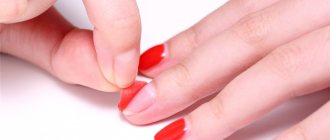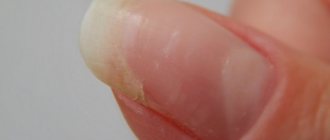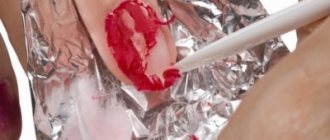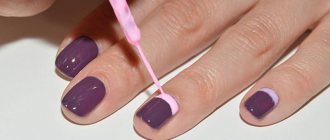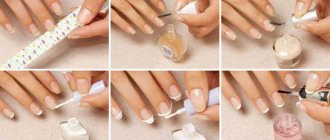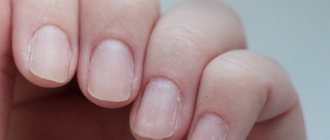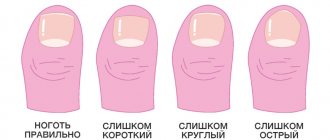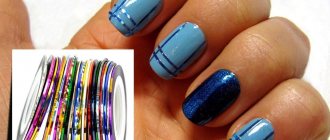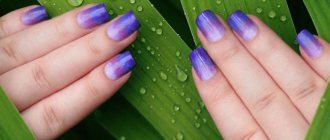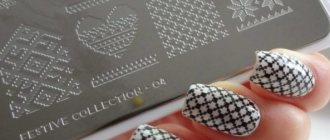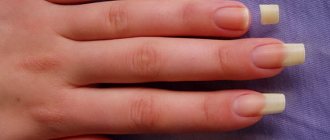What to do if your nail breaks until it bleeds?
Firstly, if the gel polish on the nails is cracked and along with it the nail is injured to the core, then it is better to forget about the perfect manicure until the plate is completely restored.
You have to sacrifice beauty for health! If a nail breaks to the point of bleeding or at the root, you should not start thinking about how to glue it, but first properly treat the wound with chlorhexidine, hydrogen peroxide or any antiseptic. Beauty is beauty, but health is much more important!
Next, wrap it with a plaster or bandage and leave the injured finger alone until the wound is completely healed, after which it is recommended to seek professional help at a salon. During healing, you need to promptly change the dressing material and lubricate the cuticle with products that promote rapid nail growth. If you plan to contact the hand, the nail on which has broken at the root, with water or chemical reagents, you must wear a rubber fingertip or even special protective gloves.
To avoid aggravating the situation, it is strongly not recommended to repair a deep plate rupture yourself.
After the wound has completely healed, you can think about how to fix the situation with your damaged manicure. The ideal option is to contact a professional. In the salon, to the question “Gel polish is cracked, how to save it,” the master will most likely answer with an offer to fix the broken nail with biogel. This is an innovative drug containing many healing substances, including protein. With the help of biogel, damaged layers of the plate and nail bed will be restored in record time. In addition, it perfectly protects wounds from infections and germs.
Biogel restoration technique
This is a universal tool that can be used for both extension and restoration of a broken nail.
This is an easy way to restore your nails and takes less than 30 minutes. There are only three stages:
- Apply biogel.
- Dry.
- Apply base, decorative gel polish and top. Dry in a UV lamp after each application.
Biogel does not tolerate the proximity of household chemicals, so cleaning the house and washing dishes should only be done with rubber gloves.
Subungual hematomas
A subungual hematoma looks like a bruise located under the nail plate.
It is formed when the small blood vessels under the nail are damaged, causing blood to pool between the nail and the nail bed. The most common cause of disruption of the integrity of blood vessels is a blow (acute injury). In addition, tight shoes can also put pressure on and damage blood vessels and cause hematoma formation (chronic injury).
As blood clots form, the color of the hematoma may change from red or purple to brown or black.
As the hematoma grows, it becomes increasingly painful as blood accumulates in the confined space under the nail and puts pressure on the delicate skin of the nail bed. Infection and inflammation of the nail bed increases discomfort and pain.
In some cases, the nail comes off from the nail bed.
Why do nails break?
Both a natural nail and one coated with gel polish or shellac can break.
In the first case, the reasons may be:
- excessive mechanical stress on the nail plates;
- excessive grinding of peeling nails;
- increased fragility due to a lack of certain vitamins,
- health problems (disturbances in the gastrointestinal tract, endocrine system and others),
- frequent contact with household chemicals and water, which causes the nail plates to become thinner and often break.
The main reason why an artificial nail can break is mechanical impact.
If you hit something hard on a nail plate coated with gel polish or shellac, a crack may appear or a piece may even break off.
If there is constant mechanical stress on the nails (typing on a keyboard and other factors), the coating often begins to peel off.
Due to a strong impact, such as a blow, a crack may even appear at the base or in the middle of the nail plate. But sometimes it happens that the appearance of cracks and chips on artificial turf is due to the unprofessionalism of the master: due to improper construction of the nail architecture or excessive removal of the top layer.
Particular attention should be paid to manicure care on the first day after extensions or gel polish coating: you should not experience sudden temperature changes on it, and also do not get too carried away with water procedures
Professional help: modeling
There is a list of restrictions for nail extensions. It is better to come to the session with the master with a manicure done three days before. This requirement is explained as follows: a form is placed under the nail, and it is necessary to have at least a minimum free edge for this.
Experienced craftsmen, when asked whether it is possible to repair a nail broken under meat, answer that anything is possible. The specialist decides on the spot which technology to use. You can use top forms, which do not require a free edge, or glue tips used for nail extensions with high pads on the fingers.
The choice of material can also be different: if the nail bed is injured, then the gel will most likely not be suitable due to heating during polymerization. Even with healthy nails there is a burning sensation, but for a wounded finger it is completely painful. Modeling with acrylic is preferable in this case - there is no heating of the material during polymerization.
Nail extension repair
Extensions are done with acrylic tips. They do not have a living structure, so if they break off, they can be glued with synthetic glue for plastic (superglue, “Moment”). The fastening materials are the same - filter paper, silk strips, paper plaster.
The technology for gluing the extended plate is as follows:
If repairing the extended nail is impossible, you can replace it with a new one.
Apply glue to the nail and place a cut-out paper strip on top of it.
Place another drop of glue on top of the strip. Apply the third layer of glue on top of the dried second.
Treat the repair area with a nail file. Apply varnish on top.
Another repair option is to replace the broken tip with a new one.
Tips for preventing the problem
To keep your nails in good condition, you need to adhere to the following recommendations:
- saw in one direction, this way you can prevent the appearance of cracks;
- do not cut it too short to avoid nails growing into the meat;
- massage your hands regularly;
- steam the nail plates before the manicure procedure;
- eat meat and fish dishes, herbs, vegetables and fruits daily;
- thoroughly dry your hands after contact with water;
- use only high-quality tools and materials for nail care.
You can keep your nails in good condition not only by following the necessary rules, but also by using the services of specialists. Salons offer the following procedures:
- wax or paraffin applications;
- spa or aromatherapy;
- Japanese manicure;
- ultraphoresis;
- sealing;
- biogel.
Such procedures should only be performed by trusted specialists.
Healthy and neat nails indicate not only the neatness of a person, but also the condition of his internal organs. Therefore, you need to regularly take care of your body, consume as many vitamins as possible and give up bad habits. It is quite difficult to prevent nail damage, but if it has already happened, you need to approach this situation wisely.
Why does my toenail turn black and hurt?
A sore toenail or fingernail has several causes:
- Traumatic nature. Depending on the bruise, you should choose the right effective treatment to get rid of unpleasant symptoms and eliminate pain
- Fungal nature - requires mandatory treatment with antifungal and antiseptic agents
- As a consequence of disruption of the internal organs, a full examination should be carried out to determine the presence of problems and diseases in the body
If the blackness of the nail is accompanied by unpleasant pain, this indicates that the integrity of the soft tissues has been compromised. In such cases, it is impossible to do without the intervention of doctors. If you do not intervene, the situation may worsen and lead to tissue suppuration.
the nail hurts, problems with nails due to bruises and fungus
How to fix a broken nail
First, it is worth noting that a nail that is more than 1/3 broken is not suitable for repair.
The matter can be corrected only with minor damage. But even after repair, you shouldn’t hope that the effect will last for a long time - such a nail can last only 2-3 days, if you handle it very carefully - a week.
| Caution: if the nail plate is broken in such a way that the soft tissue is damaged, it is better not to try to repair it. |
The fact is that in such cases there is a high risk of infection getting into the wound.
The only correct solution would be to cut all nails to the length of the broken one in order to provide your hands with an aesthetic appearance. The damaged area should be regularly treated and the condition of the phalanx tissue should be monitored. If the option of cutting all of them into one is absolutely not suitable for a broken nail, you can try to save the manicure.
Natural nail repair
To start nail repair, you need to have the following tools and tools: 1. Means for degreasing the nail plate. If you don’t have it, you can replace it with regular medical alcohol.
2. Silk with a self-adhesive base.3. Special glue for nails. It is unacceptable to replace it with Moment or similar products, since such compositions aggressively affect even healthy nail plates. If you don’t have a special one at hand, medical glue will do.4. A nail file or buff with low abrasiveness (to reduce injury to the damaged nail).5. Acrylic powder for fixing the glue layer, giving a natural shade to the nail surface, and also masking the edges of the fabric. All of the above is also sold as a special set, which is convenient to use both at home and while traveling.
Stages of natural nail repair:
1. First you should clean the surface of the nail with a soft buff. They need to move from the base of the nail upward.2. Degrease the nail plate with a special liquid or alcohol.
3. Remove the film from a piece of fabric (silk) and stick it so that the crack is completely covered. Then apply a drop of glue to the applied layer and dip the nail plate into the powder. After the glue dries a little, excess powder is removed. If necessary, the steps are repeated. If glue gets on the skin, remove it with an orange stick.
4. After the overlay has completely dried, the surface of the nail is polished with a nail file. This is necessary to remove the adhesive layer so that the nail plate becomes as smooth as possible.
Polishing is done with careful, gentle movements so as not to provoke a new crack. Then oil is applied to the surface of the nail and cuticle and polished with a buff. This is necessary in order to hide the break border as much as possible.
5. After this, apply 2 layers of opaque varnish. These manipulations will completely hide the crack.
If a piece of your nail breaks off, you can try to build it up using gel polish.
What is onychorrhexis or crack along the nail?
The beauty of your nails directly depends on their health.
It’s hard to disagree that well-groomed nails can add neatness and neatness to an image. But not in every situation the beauty of nails can be achieved with a regular manicure or pedicure. In some cases, the nail plates have serious defects, which are manifestations of somatic pathologies. Such manifestations require the intervention of a podiatrist. Violations of the integrity of the nail plate, delamination or brittleness of the nails require not only aesthetic closure with gel polish, but also treatment.
One type of nail deformation is onychodystrophy.
Onychodystrophy is a group of diseases of the nail plate, which are characterized by the appearance of changes in the color of the nail, its shape or structure. One of the pathologies of the group of onychodystrophies is onychorrhexis.
Onychorrhexis is a type of structural change in the nail plate, in which its longitudinal separation occurs. In appearance, the pathology resembles a nail crack running from the free edge to the base. The bundle can be single or multiple. As a rule, multiple onychorrhexis occurs on the fingernails, while on the feet the nail plates of the big toes are more often affected.
Onychorrhexis occurs equally often in women and men. If we single out an age category that is more susceptible to pathology, then these are elderly people.
Cracked toenail, what should I do? Such a complaint is a good reason to consult a podiatrist. The specialist will conduct a thorough examination of the defect, find out its etiology, and also draw up a treatment plan for the nail plate defect.
Causes
There are many factors that contribute to gel polish cracking on your nails.
Such reasons include:
- improper coating application;
- poor quality manicure materials;
- applying the gel in a layer that is too thin or thick;
- influence of external factors;
- unhealthy condition of the nail plate;
- incorrectly selected drying lamp;
- the presence of a sticky and greasy layer on the surface.
Gel polish can crack on both natural and extended nails. The integrity of the gel surface depends on the reason that provoked the development of this phenomenon. For example, if the manicure technique is violated, small cracks appear on the second day.
Results of incorrect application
The gel coating on the nail plate begins to crack if the technology was violated during the procedure.
Poor quality manicure results from the following reasons:
- improper cuticle removal;
- oily layer on nails;
- nails are not completely dry;
- the gel was applied to the plate after applying the cream;
- when gel polish is applied in a very thin or thick layer;
- if the base product and gel are from different manufacturers;
- with improper polishing of the nail surface.
If the master does not follow the application technology, the gel polish begins to crack on the nails within the first week after the manicure.
External factors
If the varnish is cracked, this may be due to external factors. The substances contained in household chemicals are considered the most aggressive to gel manicure.
The nail coating is damaged by:
- washing powder;
- some creams and ointments;
- detergents (especially those that clean the surface of bathtubs and sinks and contain abrasive particles);
- soap
The integrity of the gel is compromised when working with soil without protective gloves. Temperatures that are too low or high also reduce the wear time of gel polish.
Nail condition
Most often, cracks form due to a pathological condition of the nails. If the stratum corneum is very thin or soft, then the gel polish begins to quickly become damaged.
Under frequent exposure to water, powder, and detergents, the coating bursts because it does not attach well to the nail surface.
Thick layer of gel polish
Cracks begin after the material is applied too thickly.
The layer at the top of the manicure dries and decreases in size. The gel coating below, on the contrary, stretches. As a result of this process, cracking occurs.
Drying lamp
When this indicator is lower, the product does not dry completely. The sides remain wet.
To check the quality of drying, press on the coating with a pusher. If a dent appears, the gel has not dried. With incomplete drying, strength decreases.
Exposure to water
Frequent contact with water negatively affects manicure. Washing your hands frequently can cause your manicure to crack.
Remaining sticky layer
If the sticky layer is applied incorrectly or is not completely removed, then the gel polish does not adhere well to the nail plate. Cracks due to its residue appear within a few days.
Poor quality materials
One of the common reasons for cracking gel on nails is the use of low quality materials.
Usually the price for these accessories is low. Such materials are not branded.
Other reasons
Gel polish also cracks due to the following reasons:
- use of antibiotics;
- stomach diseases;
- pathologies of the heart and blood vessels;
- diseases of the endocrine system.
Such a manicure can be damaged due to hormonal changes in women, including during menstruation and pregnancy.
In rare cases, individual intolerance to the components included in the manicure product is possible.
Quick restoration of nails after gel polish
Damaged nails must be treated so that the already thinned and injured plate does not become even more deformed. To do this, you will need products that can be purchased at pharmacies or special departments of stores.
So how to restore nails after improper removal of gel polish and damage to the top layer? There are several effective means for restoring the nail plate. It is advisable to do the procedures daily and alternate them with each other.
Baths are very effective in answering the question of how to restore nails after gel polish at home. Only warm water is used. The procedure lasts 20-30 minutes. Baths are needed to prepare the skin of the hands and nails for the use of the nourishing product.
Bath with salt and lemon
Bath composition:
- Sea salt. It is enough to dissolve 2-4 teaspoons in a small bowl. The solution will disinfect and strengthen your nails.
- Chamomile - acts as an antiseptic, softens and expands the pores on the plate.
- Sage – eliminates dryness and flaking.
You can add a few drops of lemon juice into the bath to better soften the skin and plate. Or add a few drops of iodine to sea salt. Such a solution will imitate sea water and have a strengthening effect.
Other useful baths:
- with potato broth - softens and nourishes at the same time;
- 1 teaspoon each of apple cider vinegar and soda - helps restore in a short time after treatment for fungal diseases.
After using the bath, hands are thoroughly wet and a rich nourishing cream is applied. To increase its effectiveness, you can add 1-2 drops of essential oil: jojoba or almond.
Masks are also effective. They can be prepared from the following ingredients:
- Gelatin - 2 teaspoons of gelatin are dissolved in warm water, the nails are lubricated with rich cream and placed in the prepared liquid. Keep for 10-15 minutes. Nails are restored and strengthened, and their growth accelerates.
- A few drops of essential oil are dissolved in olive oil, for example, ylang-ylang, myrrh, apricot, lavender or cedar rose. Apply to the plate and leave until absorbed. The excess gets wet. The mask nourishes with beneficial microelements, fills damaged voids, smooths out scales and makes the surface smooth.
- Clay. It is separated and placed on the plate. Keep for 30 minutes. Afterwards, wash off and rub in the nourishing cream. Clay strengthens the nail and repairs damage.
- Cosmetic paraffin. You need to melt it in a water bath. Fingers are dipped into it for 10 minutes. At the end of the procedure, the residues are smoothly rubbed in and oilcloth gloves are put on your hands. Leave them on for 1-2 hours. Paraffin seals well and smoothes out roughness, nourishes and moisturizes the skin.
Nail restoration polish after gel polish
Therapeutic varnishes help restore the nail plate. This coating protects the nail, fills voids and evens out the surface. It contains vitamins and minerals, especially calcium.
Application of medicinal varnish
Medicinal varnishes include:
- Smart enamel. Available in a wide range. Apply daily. Strengthening of the plate can be seen after two weeks.
- Mavala Scientific. Apply every other day, the result is visible after a month. The product is especially effective for split nails.
- IBX System. A professional product used in salons. Nourishes and restores the plate in the shortest possible time.
- Eveline. It acts in several directions and stimulates nail growth. Apply once every 3 days. The effect occurs after 2-3 weeks.
These and other products can be purchased at the pharmacy chain. The healing coating is usually colorless; colored varnish can be painted over it.
Step by step nail repair
Especially for skeptics, the ambulance chose for clarity the option without complications, but with an asterisk. We bet you were sure that if a nail broke at the root and the tip fell off, then there was nothing left to do but cry over the trash can and trim the rest?
Ha! The professionals grin and roll up their sleeves. Everyone loves before and after photos, right? So, here you go.
Everything can be solved, your hands are not for boredom! Detailed instructions with photos will tell you how to seal a nail.
Preparation
The nail needs to be treated with a buff, remove the gloss and make the surface of the nail slightly rough. The process is similar to preparing for applying gel polish. By the way, if your nail breaks under gel polish, first remove the old coating, fix it and get a new manicure. If the nail is cracked on the side, file down the jagged edge a little. If you need to glue the tip that has fallen off, then, on the contrary, there is no need to file the broken edge. Otherwise, the “gears” will not fit together. Finally, thoroughly degrease and disinfect.
Main action
Apply glue to the nail:
Attach the broken tail and hold for a few seconds, 15-20, so that the glue “seizes”:
This is what the nail looks like both broken and glued:
Now it's the bandage's turn. If the material is adhesive-based, then the fabric can be immediately applied to the plate. If you use a tea bag or non-woven fabric as a bandage, first spread glue on the plate, then place the fabric.
The piece should not be even; all excess is cut off with scissors and filed with a nail file. Do not skimp on fabric; it is better to cover the entire plate for strength. The larger the area, the lower the pressure. The laws of physics also apply in the nail world.
Apply a layer of glue on top of the bandage, smooth it out and dry:
Armed with a buff, carefully polish the nail. Align the edges of the bandage with the plate. If there are any protruding edges and glue clumps, file them down with a coarse file.
You can apply a control layer of glue to the polished nail and lightly buff it again.
Result
Voila! Like new. Now you can paint your nails as usual. Look at the picture:
The nail on the left finger is broken on the side, on the right finger it is broken at the root. Breakdowns are marked with a red line. Nothing is impossible. This technique can be used to repair almost any damage to nails of different shapes and lengths. The proof is in the photo.
The location of the crack does not matter. If the nail is broken in the middle, the repair algorithm will not change. As long as the skin is not damaged. Don't neglect safety precautions.
By the way, when using gel polish, you can use a base coat instead of glue. In this case, you need to put a base layer on the nail and a bandage on top. Soak the bandage thoroughly with the base, you can add an additional drop on top. Only after this polymerize in a lamp.
Thanks to the nail emergency specialists for the master class. Now you can handle repairs of any complexity. If your nail suddenly breaks, you can fix it at home like a real professional. If such breakdowns occur regularly, look for the reason. Perhaps something tasty and healthy is missing from your diet. Eat fruits, vegetables, grains, meat and other good foods more often. Take care of yourself and your health. Strong claws to everyone!
A nail broke under gel polish: is it possible to revive it?
If a girl breaks her nail under gel polish, she usually doesn’t know what to do. Pay attention to this point so as not to spoil the health of the nail plate, which can lead to severe damage.
Typically, nail breakage under gel is associated with one of two factors:
- Low immunity. Insufficient supply of vitamins and microelements from the matrix to the nail plate often affects its strength, which can cause detachments, breakages and other damage to the nails. To prevent a decrease in immunity, you need to include vitamin supplements in your diet, which will accelerate metabolism and regeneration of epithelial cells .
- Mechanical load. Typically, breakdowns occur due to aggressive effects on the structure - its damage due to impact, pinching, since the gel is a strong coating that is difficult to spoil. And under mechanical pressure, it moves away from the nail, making it sensitive to external influences.
Also, when a breakdown is detected, consider its nature. The plan for restoring the health of the nail plate and the possibility of preserving the decorative coating depends on this.
Damage can have one of four manifestations:
- Lateral detachments that do not touch the main surface of the nail bed;
- A crack or chip formation on the surface itself;
- Damage to the nail matrix;
- Damage to sensitive skin under the nail, partial tearing of the surface.
The last damage can only be caused by a sudden load on the nail, due to which it is subject to severe damage.
It is possible to revive a nail that is under gel polish, but to do this, take into account the severity of its damage. If there is blood and severe pain, you should immediately disinfect the injury site and, if possible, remove the decorative covering to see the site of the breakage.
However, if only the free edge of the plate is broken, it does not need to be treated with an antiseptic, but carefully cut off without removing the gel polish.
How to repair at home?
If the nail plate is damaged, do not rush to trim the broken area and align all other nails to its remaining length. There are many proven ways to correct this situation using the most common means.
To repair nails you will need the following tools:
- disinfectant;
- special fabrics (linen, silk, artificial fiberglass);
- glue for nail restoration;
- buffs;
- nailfile.
How to seal using a tea bag?
The tea bag is made of thin fiber paper. By applying this material to the damaged nail plate, you can hide all the resulting defects. The result is not inferior to salon techniques that use silk coating. To repair a nail you will need:
- tea bag;
- high-quality base coat;
- nail file;
- device for grinding and polishing;
- scissors;
- colored varnish;
- top
Gluing procedure:
- remove nail polish;
- cut out a rectangle from the bag with a shape corresponding to the nail;
- apply a base coat to the plate and let it dry;
- attach the cut piece and smooth it, eliminating bubbles and unevenness;
- put the next layer of base on the nail;
- remove excess cellulose from the edge of the nail using a file;
- apply decorative colored varnish.
The video demonstrates how to repair a nail using a tea bag:
How to save using special glue?
You can restore your nail yourself using special glue as follows:
- wash and dry your hands well;
- put your hands in warm water to soften the plate;
- apply special glue to the nail and spread evenly over the surface using an orange stick (you can also use a toothpick);
- attach the broken part and press gently;
- after the segment is fixed, remove excess adhesive;
- perform polishing using a special file, performing the procedure in only one direction;
- apply protective varnish.
How to treat onycholysis?
The sooner you contact a podologist or dermatologist to identify the cause of nail detachment, the higher the chances of successfully eliminating the problem.
During the restoration of fingernails or toenails, there is a strict ban on any traumatic procedures, nail extensions, the use of decorative varnishes and aggressive chemical liquids.
If fungal spores have entered the cavity under the nail and onycholysis is infectious in nature, then treatment for onychomycosis is prescribed by a dermatologist.
If the nail plate on your ring finger periodically comes off, then there is a possibility that you need to seek treatment from an endocrinologist and adjust your hormonal levels.
How does gel polish compare favorably with regular polish?
Firstly, it is easier to apply - if a simple varnish, even the freshest one, is prone to gaps and stripes on the nail, then the gel, due to its density, instantly lies on the nail plate in an even layer. Often, gel polish does not require reapplication.
The second well-known advantage is the durability of the coating. This advantage can be a disadvantage for girls whose nails grow quite quickly, but if the length of your nails does not change much over the course of a week, long-lasting polish will be your salvation. Gel coating is also suitable for those with fragile, brittle nails: the gel literally “walls up” all the defects of the plate.
How to do a manicure with gel polish at home?
We will talk about all stages of this process.
Nail preparation
Any manicure should always begin with proper nail preparation. First of all, you should work with the cuticle - it should either be trimmed or carefully pushed back.
How to remove cuticle?
Even those with thin skin prone to injury can remove it, but do not forget to steam your fingers first. Soak your hands in the hot bath and then begin removing the cuticles. First, lift it with a special spatula - the skin should completely move away from the nail. After this, trim the cuticle using a sharp trimmer or well-sharpened thin scissors. If you do injure the skin around your fingers, immediately treat the wounds with peroxide and lubricate your nails with coconut or apricot oil.
If the skin around the nails is quite dense and not prone to injury, you can remove the cuticle “dry” - in this case, the procedure will be exactly the same, with the exception of the first step with warming up the fingers.
If you don’t do a trimmed manicure on principle, it’s still worth steaming the cuticle - so that it’s easier to push it back with a spatula. Even with this method of dealing with cuticles, the skin may be slightly damaged, so keep peroxide and nourishing cream on hand.
After removing or pushing back the cuticle, you should proceed to giving the nails the desired shape. The most popular one is square on short nails, but if the nail plate is set quite low, choose an oval shape - it will visually “stretch” your fingers. Everyone knows how to shape nails - using a file. But opt for a glass instrument. Do not cut your nails with clippers or scissors if they are prone to splitting - carefully file the plate to the required length.
After shaping, polish the surface of the nail with a buff, then remove dust with a brush and apply nourishing oil or cream to your fingers. Before applying gel polish to your nails, make sure that their shape is uniform and that there are no burrs or cuticle particles left around.
Varnish coating
What do you need to do a gel manicure? The basic necessary tool is an LED or UF lamp. Without it, the coating will not adhere to the nail properly, and the drying process will take much longer.
The gel polish firmly settles on the nail, therefore, to facilitate the removal process in the future, it is necessary to apply a primer to the plate - it will smooth the surface of the nail and will not allow the polish to be firmly “absorbed.” You'll thank yourself for taking this step before you remove the gel polish.
After applying the gel, you need to paint your nails with a topcoat, which will give the varnish shine and durability.
Now let's move on to the procedure.
First, coat your nails with primer, then proceed to applying the gel itself. Make single and confident movements with the brush, do not smear the polish on the surface of the nail. Place your hands into the LED lamp, being careful not to smear the gel, repeat the process if necessary. If the color saturation seems insufficient to you, apply a second coat of varnish.
After the gel, fix the result with a top coat - a protective glossy coating that will provide the varnish with greater durability.
List of sources
- vokrug-nas.ru
- ufologov.net
- salon-nagorkogo.ru
- nails-health.ru
- jawoman.ru
- idealnyi-manikur.ru
- ameno.ru
What causes a nail to turn black?
Both external and internal factors lead to blackening of the nail plate. We'll tell you more about them.
External factors
- External causes that lead to blackening of the nail include mechanical damage. In this case, the color change is the result of hemorrhage in the area. This does not cause any harm to health, and the natural shade of the nail will soon return.
- Sometimes you may not even feel the injury. Hemorrhages occur due to tight shoes, so when the blood vessels burst, pain is not felt. To understand that the cause of darkening is injury, you should pay attention to the appearance of the spot. It appears only locally, and its edges are blurred.
- The next external factor leading to a change in the color of the nail plate is its coloring. Some substances, with prolonged contact with the nail, cause it to darken. This could be, for example, potassium permanganate. In this case, there is no need to worry.
- This may also be the use of low-quality decorative varnishes that contain aggressive chemicals. They penetrate deep into the nail and are not affected by nail polish remover. You can get rid of the problem only by growing your nails.
Internal factors
There are many more internal reasons for the negative process. It is very difficult to determine a specific factor by appearance. To do this, you need to consult a doctor. Let's name the most common reasons:
- Fungus . The vital activity of fungal spores leads first to blueness and then to blackening of the nail plate. People with weak immune systems are at risk. Most often, pregnant women and teenage children become victims of fungal attacks. The blackness begins at the base and gradually reaches the middle of the plate. In this case, the help of a doctor is necessary, since self-medication will not bring the desired result. The process of getting rid of fungus usually takes a long time.
- Tumor (benign) . During this period, blood vessels grow, which lead to blackening of the nail. Here you also need urgent consultation with a specialist.
- Diseases of internal organs . The most common causes of discoloration of the plate are diseases of the cardiovascular system, kidneys, and diabetes. When the kidneys fail to cope with their functions, a large amount of skin pigment (melanin) is released into the blood. This causes the blood to thicken and the blood vessels to become clogged.
- Pigmentation . Small black dots may indicate a predisposition, at the genetic level, to increased pigmentation. The reason for this phenomenon is a change in blood pigment. This occurs for a variety of reasons: unhealthy diet, ultraviolet radiation, alcohol abuse and prolonged smoking.
- Chemotherapy . During chemotherapy, poisons and other chemicals are used that affect the color of the nail plate, causing it to darken.
